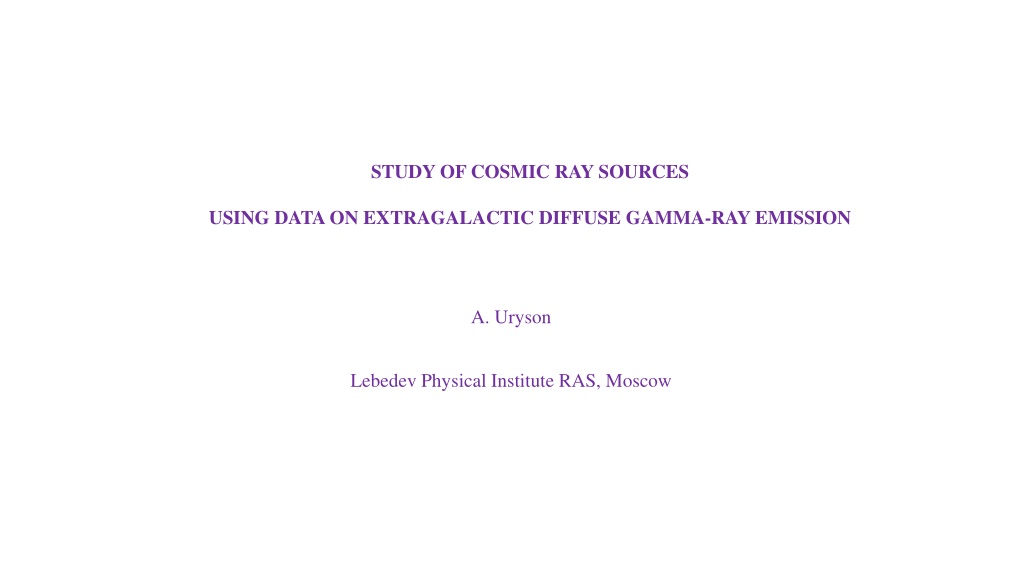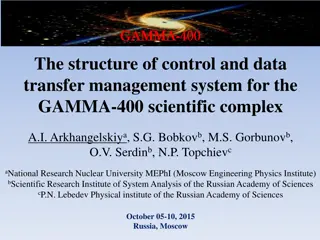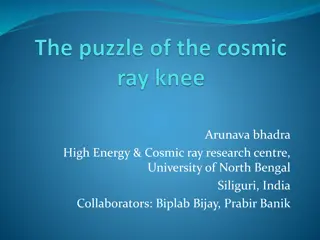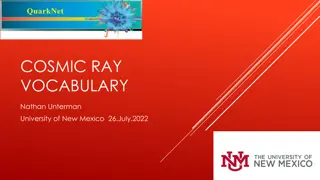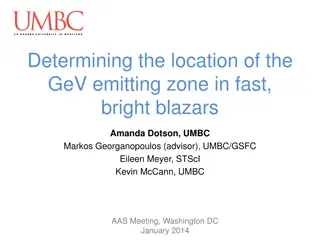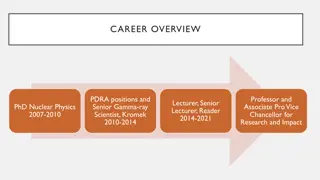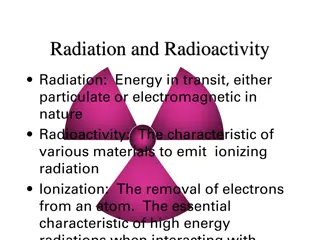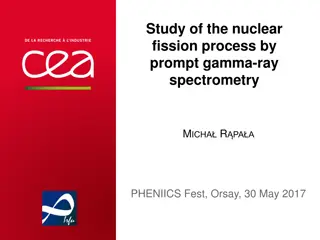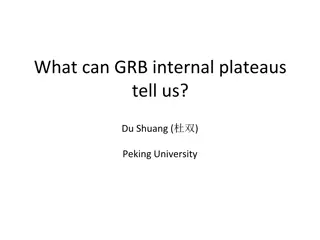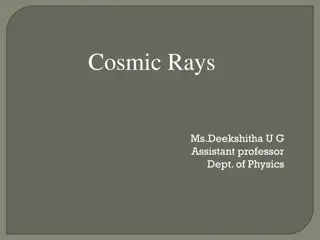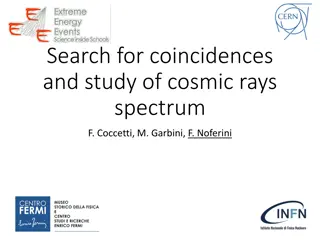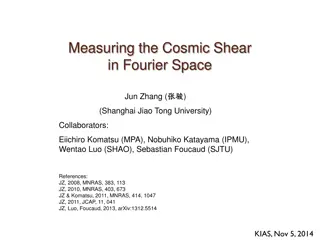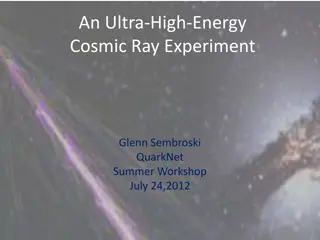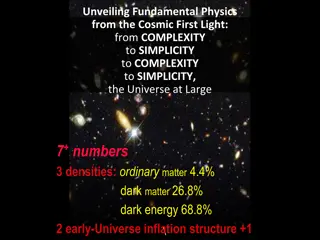Exploring Cosmic Ray Sources Using Gamma-Ray Emission Data
This study focuses on investigating ultrahigh energy cosmic ray (UHECR) sources by analyzing extragalactic diffuse gamma-ray emission data. Techniques such as examining UHECR mass composition and arrival directions, as well as studying interactions with cosmic microwave and extragalactic background light, are discussed. The research explores potential sources like active galactic nuclei (AGNs) while considering different models for acceleration mechanisms. Utilizing data from Pierre Auger Observatory and Fermi LAT, the study aims to understand the origins of UHECRs and their impact on the isotropic gamma-ray background.
Download Presentation

Please find below an Image/Link to download the presentation.
The content on the website is provided AS IS for your information and personal use only. It may not be sold, licensed, or shared on other websites without obtaining consent from the author. Download presentation by click this link. If you encounter any issues during the download, it is possible that the publisher has removed the file from their server.
E N D
Presentation Transcript
STUDY OF COSMIC RAY SOURCES USING DATA ON EXTRAGALACTIC DIFFUSE GAMMA-RAY EMISSION A. Uryson Lebedev Physical Institute RAS, Moscow
INTRODUCTION UHECR data are obtained by Pierre Auger Observatory (PAO) and Telescope Array (TA): CR energy spectrum; CR mass composition; CR arrival directions. It is supposed that UHECRs are only weakly deflected in extragalactic magnetic fields. Thus direct identification of sources is possible, using particle arrival directions. Anisotropies in the arrival directions observed by PAO and TA are also examined. No successful correlations of UHECRs with potential astrophysical sources were found by these methods. Data on CR mass composition obtained by PAO and TA are not in agreement. Sources of ultrahigh energy cosmic rays (UHECR) are presumably extragalactic objects active galactic nuclei (AGN). However they are not established and their acceleration mechanism is not clear.
ANOTHER METHOD TO STUDY UHECRs (Berezinskii et al. 2016; Gavish, Eichler 2016; Uryson, 2016) In space, UHECRs interact with cosmic microwave background and extragalactic background light. It results in electromagnetic cascades initiating by UHECRs in extragalactic space. Consequently UHECRs contribute to isotropic gamma-ray background. Isotropic gamma-ray background (IGRB) is measured by Fermi LAT. Therefore Fermi LAT data can be used for UHECR study: 1) different classes ofAGN which are possible UHECR sources are considered and UHECR spectra at the Earth are calculated; 2) gamma-ray emission Iggenerated by UHECRs in extragalactic space is calculated; 3) the calculated gamma-ray intensity is compared with Fermi LAT IGRB, and models of UHECR sources in which UHECR contribution in IGRB is Ig > Fermi LAT IGRB are excluded.
Examined models of UHECR sources are: AGNs with different evolution of density with redshift z, AGNs with different values of index in the generation spectrum E- . Here we analyze the class of AGNs in which supermassive black hole is surrounded by a superstrong magnetic field of 1010 1011Gs (in contrast to common value of 104Gs). In this model an electric induction field can accelerate CRs to extremely high energies, and CR protons escape the source at the energy of 1021eV. (Kardashev 1995-2001; Shatskii, Kardashev 2002; Kardashev et al. 2003).
THE MODEL 1) Due to acceleration mechanism we suppose the monoenergetic generation spectrum in these AGNs. 2) Parameters of extragalactic background light: (Inoue et al. 2013). 3) Evolution of density with redshift z. Two cases: 3a) weak, similar to evolution of Blue Lacertae objects (BL Lacs) (Giachinti et al. 2015); 3b) similar to evolution of radio AGNs (Smolcic et al. 2017). Computing: the public available code TransportCR (Kalashev, Kido 2015).
CR SPECTRA In both cases of cosmic evolution CR energy spectra calculated are much lower than the PAO spectrum. Thus the CR sources under consideration are only subdominant. What is the UHECR contribution to the diffuse gamma-ray emission?
CR energy spectra 25 24 23 Lg (E^3*J) (m^2 s sr eV)^-1 22 21 20 19 18 17 17.5 18 18.5 19 19.5 20 20.5 Lg E, GeV PAO Model spectrum: z-dependence: as BL Lac, injection spectrum: monoenergetic
CR energy spectra 26 Lg (E^2*J) (m^2 s sr)^-1 21 16 11 6 1 17 17.5 18 18.5 19 19.5 20 20.5 -4 -9 Lg E, GeV PAO Model: z-dependence (Smolcic et al, 2017), injection spectrum: monoenergetic
DIFFUSE GAMMA-RAY INTENSITY CALCULATED I (>50 GeV, z-dependence: BL Lac s) = 7.80x10-10 (cm-2s-1sr-1) I (>50 GeV, z-dependence: Smolcic 2017) = 1.28x10-9 (cm-2s-1sr-1) (Values are downshifted by 20% due to errors in UHECR flux.)
Fermi LAT IGRB (E>50 GeV) IGRB = unresolved sources + CR in the Galaxy + extragalactic diffuse emission Contribution of unresolved sources at E>50 GeV: 86 (+16, -14) % (Mauri 2016) Then the minimal Fermi LAT IGRB (>50 GeV) = 0.28 Fermi LAT IGRB CR in the Galaxy: foreground models (Ackermann et al. 2014) Accounting for uncertainties (including systematic ones) 2.20x10-10 FERMI LAT IGRB (without unresolved sources) 5.40x10-9(cm-2s-1sr-1)
Contribution of subdominant UHECR sources to IGRB is: I (>50 GeV, z-dependence: BL Lac s) / Fermi LAT IGRB = 0.14 I (>50 GeV, z-dependence: Smolcic 2017) / Fermi LAT IGRB = 0.24
CONCLUSION I consider AGNs with supermassive black holes surrounded by superstrong magnetic field as possible UHECR sources. It appears that these sources contribute negligibly to the CR flux at the Earth. The contribution is irrespective of cosmic evolution model. UHECRs from these objects contribute noticeably to IGRB: from 14 to 24 %. Their contribution in IGRB should be taken into account while investigating UHECR mass composition and dark matter decay with Fermi LAT data.
